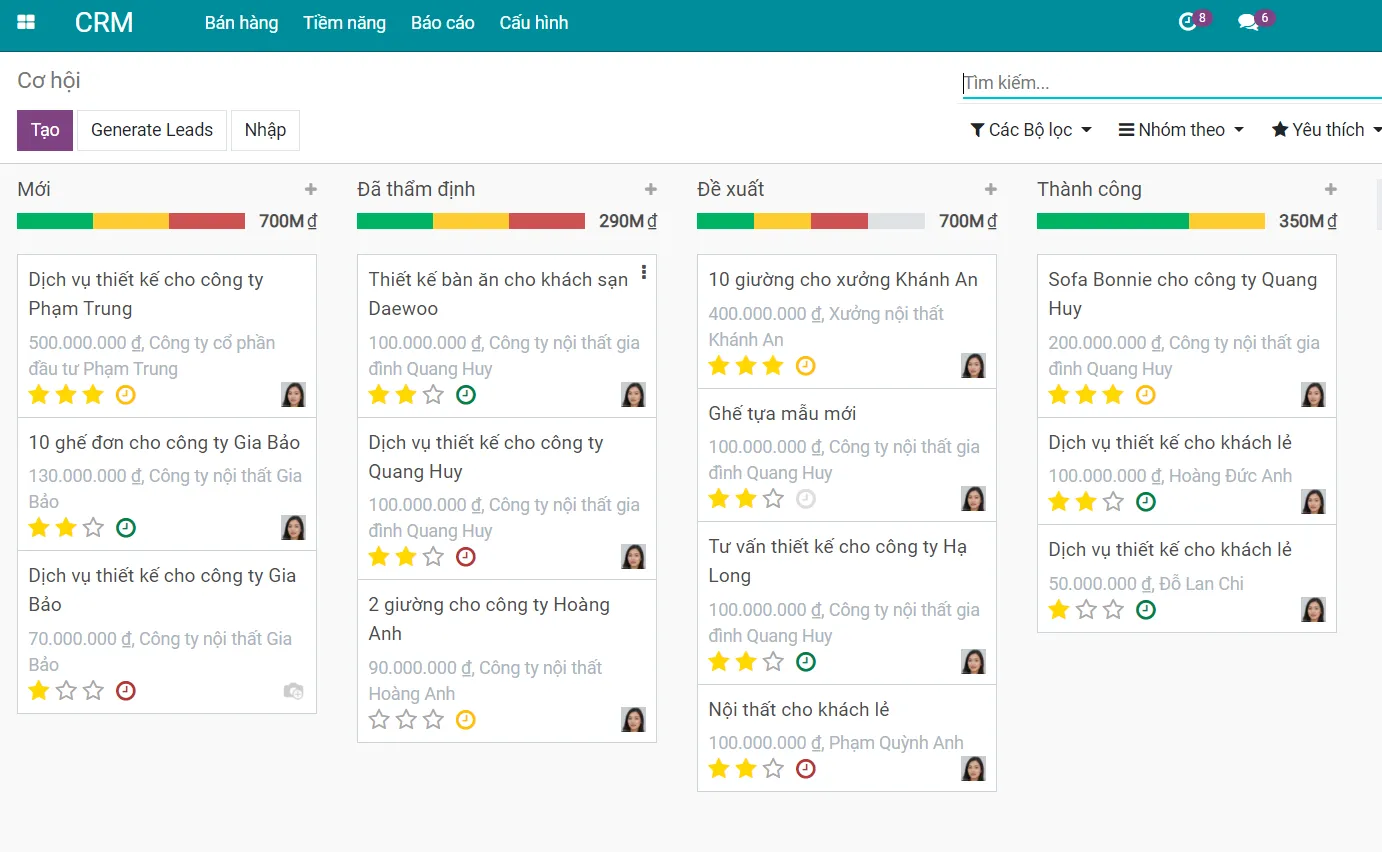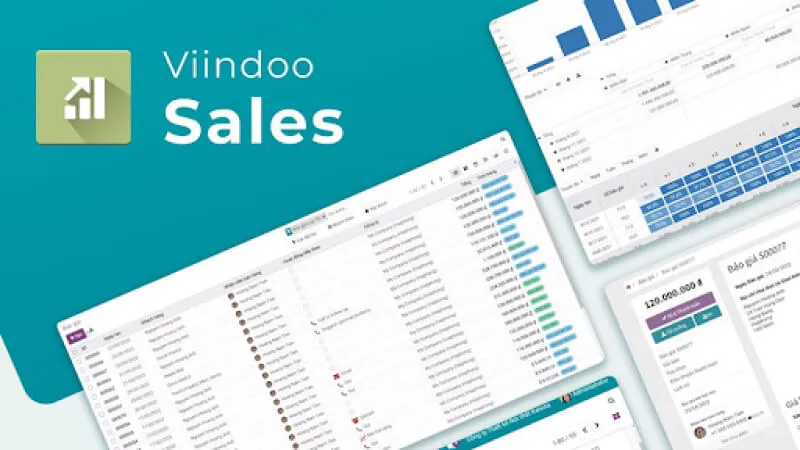Developing a sales strategy is perhaps the most crucial task that a business can undertake. Regardless of whether the focus is on B2B sales strategy, inbound, outbound, SMBs, or enterprise, a reliable source of income is necessary for a company's survival. In this article, Viindoo Enterprise Management Software will introduce to your a comprehensive guide to build sales strategy plan and basic examples.
What is a Sales Strategy?
A sales strategy serves as a blueprint for a company to establish reliable, long-term revenue streams by retaining and acquiring new and existing customers.
These plans typically include a range of elements such as specific tactics, market strategies, processes, objectives, forecasting, budgeting, and timelines. The duration of the plans varies, but they usually span over a year or two, with a particular focus on each fiscal quarter.
 What is a Sales Strategy Plan?
What is a Sales Strategy Plan?
Typically, sales strategy plans for most businesses are formulated top-down, with revenue targets set by investors, shareholders, and other C-Level executives who have a financial interest in the company. These targets can be achieved through increasing revenue, reducing expenses, or a combination of both.
>>>>> Read more: Top 10 best sales management software
The relationship between Sales Strategy and Business Strategy
The relationship between Sales Strategy and Business Strategy is closely intertwined and interacts to ensure the sustainable development of a business. Here is the relationship and interaction between these two concepts:
Business Strategy as the Foundation
Business strategy is the overall stance of the enterprise, shaping long-term development direction, primary objectives, and how the business will operate in the market. It encompasses critical decisions about what to do, where, with whom, and how to achieve long-term goals.
Sales Strategy Serving the Business Strategy
Sales strategy is a subset of the business strategy, focusing on the approach to the market and customers to execute business objectives. It contains specific plans and campaigns to generate sales, revenue growth, and market share.

Roadmap for success
Interaction in Development
The sales strategy must be formed based on the foundation of the business strategy. How you approach the market, build customer relationships, and create value must reflect the overall objectives of the business. Simultaneously, the outcomes of the sales strategy can provide crucial information to adjust and refine the business strategy.
Shaping Products and Services
The business strategy decides which products and services will be developed and created, while the sales strategy determines how they will be marketed and sold to the market.

Italic Center
Reflecting Market Realities
The sales strategy provides insights into customer feedback, sales performance, and the market. This information can play a vital role in adjusting the business strategy to align with changing market dynamics.
In summary, sales strategy and business strategy are interdependent and need to work together to achieve the overall goals of the business. The business strategy provides the overarching guidance, while the sales strategy shows the specific methods to execute and contribute to the business strategy.
How to Develop a Sales Strategy Plan
Building a Sales Strategy Plan is no easy task, as it requires the work of multiple departments and different skill sets in planning and organizing. Take a look at the following steps to build a comprehensive and effective sales strategy plan.
Understand Your Market
Research and analyze your target market, including demographics, needs, preferences, and buying behaviors. Identify key trends and market dynamics that could impact your sales efforts.

How to Develop a Sales Strategy Plan?
Set Clear Objectives
Define specific, measurable, achievable, relevant, and time-bound (SMART) sales goals for each phase or period of your plan.
Determine whether your objectives are focused on increasing revenue, expanding market share, entering new markets, or launching new products.

>>>>> Related content: ERD model for sales management
Segment Your Audience
Divide your target market into segments based on common characteristics, needs, and behaviors. Tailor your sales strategies and messages to address the unique needs of each segment
Position Your Product/Service
Clearly articulate your value proposition – how your product/service solves your customers' problems or fulfills their needs better than alternatives.
Differentiate your offering from competitors and highlight your unique selling points.
Choose Sales Channels
Select the most appropriate sales channels based on your target audience and product/service type (e.g., online, direct sales, retail, distribution, partnerships).
Ensure your chosen channels align with your customers' preferences.
Pricing and Value
Determine your pricing strategy, considering factors like costs, competition, perceived value, and market positioning.
Communicate the value your product/service delivers and justify the pricing to your target customers.
Sales Process and Methodology
Define the steps and stages of your sales process, from lead generation to closing the sale and post-sale support.
Choose a sales methodology that suits your product/service and customer interactions (e.g., consultative selling, solution selling, relationship-based selling).

>>>> Read More: Build sales goals
Sales Team and Training
Develop a marketing and promotional plan that aligns with your sales objectives and target audience.
Determine how you will generate leads, nurture prospects, and create awareness through advertising, content marketing, social media, events, and more.
Measure and Optimize
Set up key performance indicators (KPIs) to track the effectiveness of your sales efforts.
Regularly analyze your sales data to identify strengths, weaknesses, opportunities, and threats. Adjust your strategies accordingly.
Budget and Resources
Allocate resources such as budget, manpower, and technology needed to implement your sales strategy effectively.
Monitor and Adapt
Continuously monitor the market, customer feedback, and competitive landscape to stay agile and adapt your sales strategy as needed.

Remember, a successful Sales Strategy Plan is dynamic and flexible, allowing you to respond to changes in the market and customer behavior. Regularly review and update your plan to ensure its relevance and effectiveness.
>>>> Read More: Sales conversion rate
Building a sales strategy with the Viindoo solution
Technology is an enabler, and its effective implementation requires alignment with your overall sales strategy and objectives. It's essential to assess your specific needs, evaluate available technologies, and tailor their adoption to support your unique sales approach.
Viindoo's solution is an integrated software ecosystem designed for businesses, providing comprehensive information technology solutions to optimize workflow and enhance operational efficiency
Building a sales strategy with the help of Viindoo systerm can be highly beneficial in improving sales effectiveness and efficiency. Here are some key areas where technology can support the development of a sales strategy:
Viindoo CRM plays a critical role in supporting and enhancing sales strategy
Implementing a Customer Relationship Management (CRM) system allows you to effectively manage customer data, track interactions, and analyze customer behavior. It enables you to segment your customer base, identify potential leads, and nurture existing customer relationships, ultimately driving sales growth.
Viindoo CRM gives you an overview of Sales, Marketing, Support, etc in customer relationship management

CRM (Customer Relationship Management) and sales strategy are closely intertwined as CRM plays a critical role in supporting and enhancing sales strategies. Here's how CRM can contribute to the development and execution of an effective sales strategy:
- Centralized Customer Data: CRM systems provide a centralized repository for storing and organizing customer information. This includes contact details, communication history, purchase history, preferences, and more. Access to comprehensive customer data enables sales teams to better understand their prospects and customers, tailor their approach, and personalize interactions.
- Lead Management: CRM systems facilitate lead management by capturing and tracking leads throughout the sales pipeline. Sales teams can assign leads, prioritize follow-ups, and track interactions and progress. This ensures that leads are effectively nurtured, reducing the chances of missed opportunities and improving conversion rates.
- Sales Pipeline Visibility: CRM provides visibility into the sales pipeline, allowing sales managers and team members to track the progress of deals, identify bottlenecks, and take proactive actions. It enables accurate forecasting, helps prioritize efforts, and ensures a consistent and organized sales process.
- Opportunity Management: CRM systems support effective opportunity management by providing tools to track and manage sales opportunities. Sales teams can update opportunity stages, add notes, schedule activities, and collaborate with colleagues. This enables a structured approach to pursuing deals, improves communication, and increases the chances of successful conversions.
- Sales Analytics and Reporting: CRM platforms offer robust reporting and analytics capabilities. Sales teams can generate reports on key sales metrics, such as revenue, win rates, conversion rates, and sales performance. These insights help identify trends, measure the effectiveness of sales strategies, and make data-driven decisions to optimize sales efforts.
- Sales Collaboration and Communication: CRM systems facilitate collaboration among sales team members by providing a centralized platform for sharing information, updates, and insights. This fosters teamwork, improves communication, and ensures that everyone is aligned and working towards common sales objectives.
By leveraging CRM effectively, businesses can develop and execute sales strategies with a customer-centric approach, enhance sales team productivity, improve customer engagement, and drive revenue growth. CRM serves as a powerful tool to support the entire sales process, from lead generation to closing deals and nurturing long-term customer relationships.
Sales Analytics and Reporting in Viindoo system

Utilize sales analytics tools in Viindoo to gain insights into sales performance, identify trends, and measure the effectiveness of your sales strategies. This data-driven approach helps you make informed decisions, optimize sales processes, and focus on areas that generate the best results.
- All data reports are completely accurate and automatically updated in real-time.
- Easily customize your own reports with smart measures and filters.
- Visualize data in diverse charts (line/ pie/ bar charts) and filter them with a Pivot table.
- Analyze customer behavior, evaluate trends and shopping habits by segments with Cohort charts.
Viindoo Sales Force Automation
Automating repetitive and time-consuming tasks such as data entry, lead management, and quote generation can free up your sales team's time, allowing them to focus on building relationships and closing deals. Sales automation tools streamline processes and improve overall productivity.
To build a sales team with Viindoo Sales Team, Viindoo Sales Target... Organize the Sales team based on regions, delegate management authority, and set sales targets for each team and individual employee.

Sales team management
Digital Marketing and Lead Generation by Viindoo Website
Leverage digital marketing techniques, such as search engine optimization (SEO), social media marketing, and content marketing, to generate leads and drive traffic to your sales channels. Utilize technology platforms and analytics to track lead sources, measure campaign effectiveness, and optimize your marketing efforts.
All-in-one website builder optimizes on-page SEO, nutures brand trust for businesses and accelerate growth..

Viindoo Mobile Sales Tools
Equip your sales team with mobile devices and sales apps that enable them to access customer information, update sales activities on the go, and provide real-time quotes and proposals. Mobile tools enhance sales agility and enable your team to be responsive and productive while in the field.
The new Viindoo Mobile app for mobile device provides access to all Viindoo applications directly from your mobile phone. Every application in your Viindoo database is available from one native app, allowing you to maintain your records, reports, sales, content management, and more while on-the-go. Push notifications keep you informed of every task or action you follow, and the adaptive content delivery system ensures that every screen is optimally viewable from any device size.
Sales Strategy Plan examples
Sales management strategies are essential to the success of any business. By having a clear and effective sales strategy in place, businesses can improve their chances of attracting and retaining customers, increasing revenue, and staying ahead of competitors. Read the following examples to apply it to your business.
Become a thought leader
To become a thought leader, you need to establish yourself as an expert in your field and provide valuable insights and opinions to your audience. Here are some steps you can take:
- Find your niche: Identify a specific area within your industry that you're passionate about and knowledgeable in.
- Create content: Share your ideas and opinions through blog posts, articles, podcasts, videos, or social media.
- Network: Attend industry events, engage with peers on social media, and build relationships with other thought leaders.
- Stay up-to-date: Stay informed about the latest developments and trends in your industry by reading industry publications, attending webinars and conferences, and participating in online discussions.
- Be authentic: Share your personal experiences and opinions, and don't be afraid to challenge conventional wisdom or offer new perspectives.
- Provide value: Offer practical advice and insights that your audience can use to improve their own work or business.
- Engage with your audience: Respond to comments, ask for feedback, and start conversations with your followers.

Become a thought leader to gain reputation as expert in your industry.
By following these steps and consistently producing high-quality content, you can establish yourself as a thought leader in your industry and gain a reputation as a go-to source for insights and advice.
Be prepared for customization
During your sales interactions, it is important to be prepared for encountering customers who have specific and distinctive requirements. This is quite normal when dealing with businesses that have varying organizational structures and diverse needs.

Be prepared for customization
Rather than responding with negative statements such as "you won't" or "you can't," it is essential to ensure that your sales approach is flexible enough to accommodate the customer's preferences. This means being open to adapting your strategy to fulfill their demands, even if it requires putting in additional effort or modifying your usual practices.
By doing so, you can build stronger relationships with your customers, enhance your reputation as a reliable and customer-focused salesperson, and ultimately achieve greater success in your sales career.
For example, at Viindoo, we assist Business in expanding, customizing, and adding features to suit specific requirements that other software cannot meet.
Value for Customers with Viindoo’s customization service:
- Customized features tailored to specific needs
- In-depth advice from a team of experts
- Commitment to quality
- Cost savings for business development and operation
- Compatibility with existing functions and high scalability
- Automatic robot quality control system
- Ownership of Customizations
Implement a free trial
According to HubSpot's sales strategy report, one of the most effective methods to convince potential customers to buy your product is by offering a free trial or a freemium version.
Free trials were found to be 76% effective, while freemium options were 69% effective in converting prospects into paying customers, as demonstrated in a graph representing the popularity of free trial offerings.

Implement a free trial
By providing a free trial, you are giving potential customers the chance to try out your product without making a commitment. You can set limitations on the free version, such as restricted features or usage caps.
Not only does this provide prospects with a risk-free opportunity to try your product, but it also helps to build brand loyalty and expand your customer base. Prospects who have a positive experience using the free version are more likely to convert to the paid version in the future.
Discover Viindoo Sales Software
The All-in-one Sales Software for SMEs. Simple operations, motivating the team to exceed business targets to increase sales.

In conclusion, building a sales strategy plan is crucial for the success of any business. By following the guides and examples provided, businesses can create an effective plan that aligns with their goals and objectives, increases revenue, and strengthens customer relationships. Continuous evaluation and adaptation are essential for continued success.
